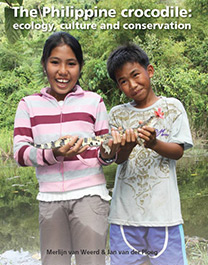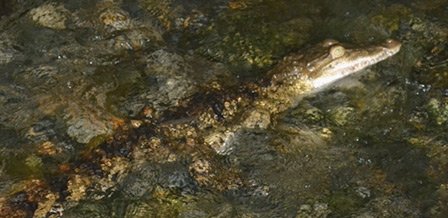సైట్
ఫిలిప్పీన్స్ యొక్క ఉత్తర ద్వీపం తూర్పు తీరంలో, నోథర్న్ సియెర్రా మాడ్రే నేచురల్ పార్క్.
కళింగ సియెర్రా మాడ్రే యొక్క స్వదేశీ ప్రజలు, అటవీ సరిహద్దుపై బదిలీ సాగు సాధన. వారు చాలాకాలంగా ఫిలిప్పీన్స్ మొసలితో శాంతియుతంగా కలిసి ఉన్నారు (క్రోకోడైలస్ మిండోరెన్సిస్). వారు తమ పూర్వీకుల స్వరూపం అని నమ్ముతారు, కళింగ వారి సంస్కృతిలో సరీసృపాలను కేంద్రంగా ఉంచండి. ఆధునికీకరణ ఈ ప్రాంతంలోకి ప్రవేశిస్తుంది, అయితే, సాంప్రదాయ ఆచారాలు మరియు విలువలు వేగంగా మారుతాయి, సాంస్కృతిక విలువలను బెదిరించడం, ఎక్కువగా అనాలోచితంగా ఉన్నప్పటికీ, ఇప్పటి వరకు స్థానిక మొసళ్ళ పరిరక్షణకు దారితీసింది.
ఎకాలజీ మరియు జీవవైవిధ్యం
ఉత్తర సియెర్రా మాడ్రేకు ఉష్ణమండల వాతావరణం ఉంది, ఫిబ్రవరి మరియు మే మధ్య పొడి కాలంతో. పార్కులో రెండు మొసలి జాతులు సంభవిస్తాయి: సి. పోరోసస్ మరియు స్థానిక సి. Mindoorensis. పక్షి జాతుల సంఖ్య ఓవర్ 200 మరియు స్థానిక ఫిలిప్పీన్ ఈగిల్ కూడా చేర్చండి (పిథెకోఫాగా జెఫెరి), ఫిలిప్పీన్స్ ఈగిల్-గుడ్లగూబ (బుబో ఫిలిపెన్సిస్), లుజోన్ హార్న్బిల్ (పెనెలోపైడెస్ మనీలే), ఫిలిప్పీన్స్ డ్వార్ఫ్ కింగ్ ఫిషర్ (సెక్స్ మెటానస్).
బెదిరింపులు ఫిలిప్పీన్ మొసళ్ళు ప్రధానంగా వేట మరియు ఆవాసాల నష్టం ద్వారా బెదిరించబడతాయి. మొసలి తొక్కలు అంతర్జాతీయ మార్కెట్లో లాభదాయకమైన ఉత్పత్తి. మొత్తం పర్యావరణ వ్యవస్థ యొక్క క్షీణత మానవ జనాభా పెరుగుదల ద్వారా నడపబడుతుంది. చిత్తడి నేలలు మరియు చెరువులు వరి పొలాలుగా మార్చబడుతున్నాయి. మడ అడవులను అగ్ని కలప కోసం మరియు నది ఒడ్డున కోత మరియు సిల్టేషన్కు దారితీసే తోటలకు మార్గం చూపడం. తదనంతరం స్థానిక నదులు పురుగుమందులు మరియు వ్యర్థాల ద్వారా కలుషితమైనవి.
సంరక్షకులు
కాలింగా వెనుకబడిన లేదా పాత ఫ్యాషన్ అని నమ్ముతున్న ప్రధాన స్రవంతి సమాజం ఎగతాళి చేయబడింది, కళింగ వారి పురాతన అలవాట్లు మరియు ఆచారాల గురించి మాట్లాడటానికి ఇష్టపడరు. పూర్వీకుల డొమైన్లలో కళింగ సాధారణంగా మొసళ్ళను వారి సంస్కృతి ప్రకారం వారి పూర్వీకులుగా గ్రహిస్తారు, మొసలి గురించి చంపడం లేదా చెడుగా మాట్లాడటం వలన అది ప్రతీకారం తీర్చుకుంటుంది. మీరు అనారోగ్యానికి గురవుతారు.
కాలేంగా ప్రజలు స్థానిక ఉత్సవాలు మరియు వైద్యం ఆచారాల సమయంలో పూర్వీకులకు మొసలి ఆకారపు బియ్యం కేకులను అందిస్తారు, మరియు చిన్న సమర్పణలు అవి ఒక నదిని దాటబోతున్నప్పుడు. బుగేన్, లేదా సాంప్రదాయ వైద్యం, కమాండ్ క్రోకోడైల్స్ లేదా ట్రాన్స్ సమయంలో ఒకటిగా మారుతుందని నమ్ముతారు.
క్రైస్తవ మతం ఈ ప్రాంతంలోకి ప్రవేశించింది, చాలా కాలింగా వారి సాంప్రదాయ విలువలు మరియు అభ్యాసాలను వదులుకుంటాడు. కాలింగా ప్రజలు ఇప్పటికీ స్థానిక పర్యావరణం పట్ల గౌరవం చూపించినప్పటికీ, వారు వారి పూర్వీకుల భూములను తొలగించారు.
"మీరు మొసలిని గౌరవిస్తే, మొసలి మిమ్మల్ని గౌరవిస్తుంది."
సంకీర్ణ
రక్షణ కోసం ప్రభుత్వ వనరులు కొరత, మరియు పరిరక్షణ ప్రధానంగా సమాజ-ఆధారితమైనది. మాబువే ఫౌండేషన్ చొరవకు నాయకత్వం వహిస్తుంది, స్థానిక ప్రభుత్వాల మద్దతు, ఇసాబెలా స్టేట్ యూనివర్శిటీ, పర్యావరణ మరియు సహజ వనరులు మరియు గ్రామీణ వర్గాల విభాగం.
పరిరక్షణ టూల్స్
కొనసాగుతున్న పరిశోధన పర్యావరణ వ్యవస్థల ప్రస్తుత స్థితి గురించి జ్ఞానాన్ని అందిస్తుంది, మరియు అడవిలో మొసళ్ళను సంరక్షించే ఎంపికల గురించి. ఈ ప్రాంతంలో పశువుల రక్షణ అభయారణ్యాలతో నిర్ధారించబడుతుంది: చేపల జనాభా బలంగా ఉండటానికి ఫిషింగ్ నిషేధించబడిన ప్రదేశాలు. ఈ అభయారణ్యాలు ఫిలిప్పీన్ మొసళ్ళకు సంతానోత్పత్తి ప్రదేశాలుగా కూడా పనిచేస్తాయి. ప్రోత్సాహంగా, గ్రామాలు అందుకుంటాయి 1000 అడవిలో ఉన్న ప్రతి మొసలికి పెసోస్.
ఫలితాలు
బహిరంగ అవగాహన ప్రచారం నెమ్మదిగా క్రోకోడైల్స్ పట్ల ఉన్న అవగాహనలను మరియు వైఖరిని మారుస్తుంది, జంతువులపై గౌరవం మరియు పర్యావరణ చట్టం గురించి జ్ఞానం. స్థానిక సంఘ సభ్యుల పరిరక్షణ చర్యలు మరింత మొసళ్ళు కొట్టడానికి విజయవంతంగా సహాయపడ్డాయి. 109 ఫిలిప్పీన్ మొసళ్ళు పుట్టాయి, గతంలో పెంచబడింది మరియు విడుదల చేయబడింది 10 సంవత్సరాల. పుస్తకం “ఫిలిప్పీన్ మొసలి: ఎకాలజీ, సంస్కృతి మరియు పరిరక్షణ ”ఒక మైలురాయి, విలువైన సమాచారం యొక్క అవలోకనాన్ని సృష్టించడం, ఇది భవిష్యత్తులో దాని పరిరక్షణకు మద్దతు ఇస్తుంది మరియు ప్రాచుర్యం పొందుతుంది.
విజన్
క్రోకోడైల్స్తో సహజీవనం సాధ్యమేనని స్థానిక ప్రజలు ప్రదర్శిస్తున్నారు. కొత్తగా స్థాపించబడిన చట్టాలను నిర్వహించడానికి స్థానిక మేయర్ చేసిన ప్రయత్నాలు సాంప్రదాయకంగా నేర్చుకోని వారికి మొసళ్ళతో ఎలా సహజీవనం చేయాలో అదనపు ఉద్దీపనగా ఉపయోగపడతాయి. ఫిలిప్పీన్స్ మొసలి మరియు దాని జీవన పరిసరాల యొక్క విధి స్వదేశీ మరియు స్థానిక ప్రజల నుండి అనేక మంది వాటాదారులను వివిధ స్థాయిల పాలనలో నిర్ణయాధికారులకు కలిగి ఉంటుంది..
"ప్రజలు మొసళ్ళ వెనుక నదులను దాటేవారు."
యాక్షన్
క్రోకోడైల్ పరిరక్షణ చర్యలు అప్పటి నుండి ఎక్కువగా సమాజ-ఆధారితమైనవి 2005, శాన్ మరియానోలోని ప్రజలు క్రోకోడైల్ గూళ్ళ కోసం చురుకుగా చూస్తారు మరియు వాటిని విధ్వంసం నుండి రక్షించడానికి సరిహద్దులు మరియు కంచెలను ఉంచారు. మొసలి ఆవాసాలను పునరుద్ధరించడానికి నిస్సార చెరువులు నిర్మించబడ్డాయి, ఇక్కడ బాల్యదశలు సరైన పరిస్థితులలో పెరుగుతాయి. మాబువే ఫౌండేషన్ యొక్క కార్యక్రమం అడవిలో మొసళ్ళ సంఖ్యను క్రమంగా పెంచడానికి సహాయపడుతుంది.
విధానం మరియు చట్టంపై
ఫిలిప్పీన్స్ ప్రభుత్వం నార్తర్న్ సియెర్రా మాడ్రే నేచురల్ పార్కును ప్రకటించింది 1997. ఈ ప్రాంతం యునెస్కో యొక్క ప్రపంచ వారసత్వ ప్రదేశంగా సమర్పించబడింది. ఇది పైభాగంలో జాబితా చేయబడింది 10 ఫిలిప్పీన్స్లో ప్రాధాన్యత రక్షిత ప్రాంతాలు.
ఫిలిప్పీన్ మొసలి రిపబ్లిక్ చట్టం ద్వారా రక్షించబడింది 9147. ఒక నమూనాను చంపడం లేదా దాని ఆవాసాలను నాశనం చేయడం వలన జరిమానా విధించబడుతుంది 100.000 పెసోస్ లేదా ఆరు సంవత్సరాల జైలు శిక్ష. అయితే, ఈ చట్టం చాలా అరుదుగా జరుగుతుంది మరియు స్థానిక నివాసితులలో చాలా మందికి చట్టం గురించి తెలియదు.
- నార్తర్న్ సియెర్రా మాడ్రే నేచురల్ పార్క్ యొక్క యునెస్కో నామినేషన్ మరియు బఫర్ జోన్ తో సహా బయటి ప్రాంతాలు: Whc.unesco.org
- బాడ్ ఫౌండేషన్: www.mabuwaya.org
- వాన్ వెర్డ్, M. & J. వాన్ డెర్ ప్లోగ్. 2012. ఫిలిప్పీన్ మొసలి: ఎకాలజీ, సంస్కృతి మరియు పరిరక్షణ. కాబాగన్: బాడ్ ఫౌండేషన్.
- వాన్ డెర్ ప్లోగ్, J. 2012. స్నేహపూర్వక మొసళ్ళు మరియు ప్రతీకార పూర్వీకులు: డినాంగ్ క్రీక్లో తీవ్రంగా అంతరించిపోతున్న ఫిలిప్పీన్ మొసలిని పరిరక్షించడం. వెర్సురెన్లో, B., వైల్డ్, R. 2012. పవిత్రమైన సహజ సైట్లు: జీవసంబంధ వైవిధ్య మూలాలు. లాంగ్స్కేప్ వాల్యూమ్ 2 పేజీలు. 48-53
- వాన్ డెర్ ప్లోగ్, J. 2013. కేమాన్ మింగారు: ఫిలిప్పైన్ మొసలి పరిరక్షణలో సాంస్కృతిక విలువలను సమగ్రపరచడం. పీహెచ్డీ థీసిస్, లీడెన్: లీడెన్ విశ్వవిద్యాలయం.





